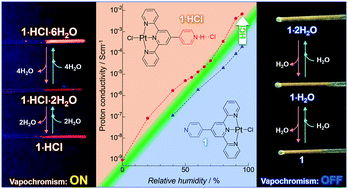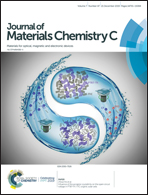Vapochromic luminescent proton conductors: switchable vapochromism and proton conduction of luminescent Pt(ii) complexes with proton-exchangeable sites†
Abstract
Two luminescent and highly proton-conductive Pt(II) complexes [PtCl(tpypy)]Cl and [PtCl(tpypyH)]Cl2 (1 and 1·HCl, respectively; tpypy = 2,2′: 6′,2′′-terpyridine-4′,4′′′-pyridine) were successfully synthesized. X-ray analysis revealed that the intermolecular Pt⋯Pt interaction was ineffective in the monohydrated form of 1·H2O but effective in dihydrate and hexahydrate forms, 1·HCl·nH2O (n = 2 and 6). Yellow luminescence (λem = 519 nm and Φ = 0.016) assigned to intraligand 3π–π* phosphorescence was observed for 1·H2O, whereas a stronger red emission ascribable to the phosphorescence from the triplet metal–metal-to-ligand charge transfer (3MMLCT) state was observed for the HCl adduct 1·HCl·nH2O (λem = 741 nm, Φ = 0.06 for n = 2, λem = 642 nm, and Φ = 0.10 for n = 6). Both complexes exhibited strong relative humidity (RH)-dependent proton conductivity, while surprisingly high conductivity was observed for 1·HCl (6.8 × 10−3 S cm−1) at 95% RH at 298 K. The reversible transformation between 1 and 1·HCl was achieved upon exposure to humid HCl gas and heating and their vapochromic behaviour was completely different owing to the presence of acidic N–H protons and the additional hydrophilic Cl− counter anions in 1·HCl. To the best of our knowledge, these complexes are the first switchable vapochromic and highly proton conductive materials that can be employed to visualize the proton conducting state by colour and luminescence.



 Please wait while we load your content...
Please wait while we load your content...